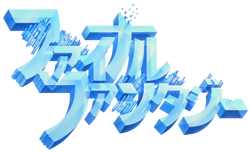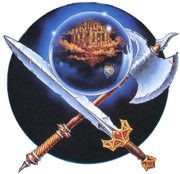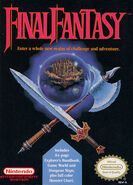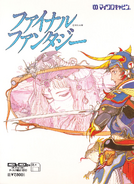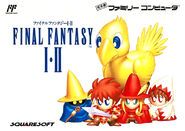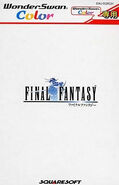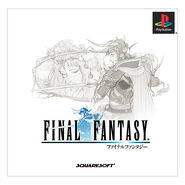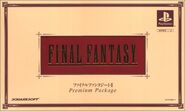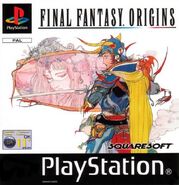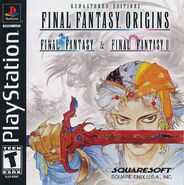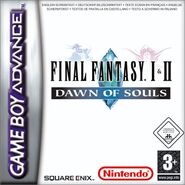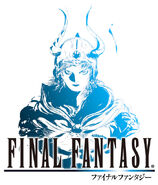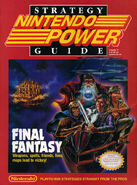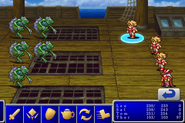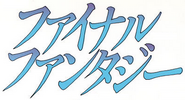Final Fantasy, also known as Final Fantasy I in re-releases, is a role-playing game developed and published by Square Co., Ltd. for the Nintendo Entertainment System in Japan in December 1987, and the first title in Square's flagship Final Fantasy series. The game was later released in North America in 1990, and has since been re-released worldwide on the PlayStation, the Game Boy Advance, the PlayStation Portable, iOS, Android, and many other platforms, with re-releases making modifications and adding new content. The game was directed by Hironobu Sakaguchi, with Nobuo Uematsu composing the score (as his sixteenth work of video game music composition).
The game puts players in control of four characters known as the Warriors of Light, and begins by asking the player to select the classes and names of each. The Warriors of Light can traverse the maps of dungeons and towns, which are connected by a world map, and will run into random encounters with enemies or fight bosses. Battles are controlled using menus in a turn-based fashion, in which characters can use attacks and Magic, depending on the class they have equipped.
Final Fantasy takes place in a fantasy medieval setting with three major continents, and the four Warriors of Light begin in Cornelia. They are tasked by the King of Cornelia to rescue Princess Sarah from Garland, and after defeating him, the king opens up a bridge enabling them to pass to the town of Pravoka. This sets them off on an adventure to defeat the Four Fiends and rescue the world.
Gameplay[]
Final Fantasy begins by asking the player to select the character classes and names of each of the Warriors of Light (the player characters). Like most computer role-playing games of that era, the player characters are passive participants in the story. Thus, the player's choice of character class will only affect the Light Warriors' abilities in battle.
The character types are:
- Warrior (Fighter) — A specialist in heavy weapons and armor who can withstand punishment. Will become the Knight, able to use the most powerful weapons and some White Magic spells.
- Monk (Black Belt) — A martial arts expert who is best left fighting empty-handed, but may also wield nunchaku, and the most basic of staves. Does tremendous damage in combat, but cannot wear heavy armor. Becomes the Master. In the original Famicom/NES version a high level, barehanded Master, who is unencumbered by armor, can do more damage in a single attack than any other character type; a party of four Masters can defeat the final boss in less than two full rounds. Though a rather weak class in the beginning, the player never has to buy much equipment for him, thus saving gil.
- Thief — A high evasion/accuracy finesse fighter with limited weapon and armor selection, but greater agility and luck (ability to escape from combat). The ability to flee is bugged in versions before the Origins release. The Thief will be upgraded to the Ninja class who can use almost every weapon and most armor, and can use many Black Magic spells.
- White Mage — A specialist in White Magic. Not a good fighter, but can use hammers for physical attacks and focuses on supporting the team with healing and enhancing spells. Will be upgraded into a White Wizard, which allows the character to use the most powerful White Magic spells.
- Black Mage — A specialist in Black Magic, but is physically frail. Becomes the Black Wizard who can cast Flare (NUKE in the original North American localization), one of the two damaging spells that retain full effectiveness against the final boss (the White Wizard can cast Holy, but it is less powerful).
- Red Mage — A jack-of-all-trades, able to use most but not all of White and Black Magic, and fights similar to, but not quite as well as, the Fighter. Becomes the Red Wizard.
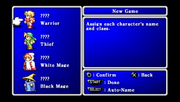
Naming a character (PSP).
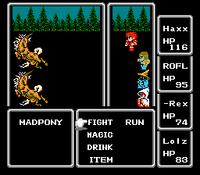
A battle against two MADPONY, later translated as Crazy Horse (NES).
Gameplay is similar to that of many other console role-playing games. The player wanders around a world map, randomly encountering monsters, which must be either dispatched in battle or fled from. Emerging victorious in battle earns the player gil, which can be used to buy weapons, armor, curative items, and magic spells.
Victory also grants experience, which accumulates until players achieve certain milestones ("experience levels") at which characters gain greater capacity for strength, damage resistance (known as Hit Points, or HP), and spell casting. The player can enter towns on the world map to be safe from random attacks, restore HP and spell charges, acquire information by talking to villagers, and shop. Battle is turn-based, i.e. players select the desired actions for their party (Fight, Cast Spell, Run, etc.), and when finished the characters execute their actions while monsters retaliate depending on their Agility.
Every version of Final Fantasy also has a secret minigame, 15 Puzzle, that can be played out on the sea.
Synopsis[]
Setting[]
Final Fantasy takes place in an unnamed fantasy world with three large continents. The world's elemental powers are determined by the state of four glowing crystals ("orbs" in the original North American localization), each governing one of the four classical elements: earth, fire, water, and wind.
Story[]
And so their journey began. The four Warriors of Light felt overwhelmed by the great task destiny had placed upon them. They did not know the true significance of the four crystals they held in their hands... The crystal that once, long ago, shone with a light so brilliant. The time for their journey had come. The time to cast off the veil of darkness and bring the world once more into the light...
Opening scene
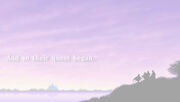
The Light Warriors begin their quest.
About four centuries ago, the Lufenian people used the wind crystal's power to build a giant flying fortress and airships. The wind crystal eventually lost its light, which drove the Lufenians' homeland into decline. Tiamat, the fiend of wind, attacked the Lufenians and took over their flying fortress, along with the Mirage Tower. In response, the Lufenian Cid hid an airship in the southern continent.
Two centuries after Tiamat, the Fiend of Water Kraken sunk the center of an oceanic civilization to make it his personal lair and darken the water crystal.
In the present day, two centuries after Kraken, the fiend of earth Lich awakens and darkens the earth crystal, causing the land around Melmond to decay. At an unspecified point, the sage Lukahn tells of a prophecy about four "Warriors of Light", who will save the world in a time of darkness.
The four Warriors of Light arrive at the kingdom of Cornelia, each carrying a darkened crystal of each element. They are recruited by the King of Cornelia to rescue the kingdom's princess Sarah, who has been kidnapped by the rogue Cornelian knight Garland. After Garland is defeated at the Chaos Shrine, Sarah rewards the Warriors of Light with her lute and the drawbridge is rebuilt to allow them to pass east.
While traveling east, the Warriors of Light liberate the town of Pravoka from a band of pirates, who give up their ship in defeat. However, the only way out of the Aldean Sea is blocked by a land bridge that the dwarves of Mount Duergar have been trying to demolish.
They eventually search for the dark elf Astos, who has stolen a crystal eye that allows the witch Matoya to see; put the Prince of Elfheim into a coma; and stolen the crown of the Western Keep's king. The Warriors of Light retrieve the stolen crown from the Marsh Cave, only to find that the western king is Astos in disguise. They defeat Astos and recover the Crystal Eye, allowing Matoya to brew a potion that will awaken the Prince of Elfheim. The Prince rewards the Warriors of Light with the Mystic Key, which allows them to retrieve Nitro Powder from a locked room in Castle Cornelia. They immediately take the Nitro Powder to be detonated at Mount Duergar, allowing the dwarves to clear a path out of the Aldean Sea.
The Warriors of Light sail to Melmond, whose villagers blame the decay of their land on a vampire hiding in the Cavern of Earth. The vampire yields a Star Ruby in defeat, but this does not stop the decay. After taking the Star Ruby to the Giant's Cave, the warriors receive a rod from the sage Sadda, allowing them to go deeper into the Cavern of Earth and defeat the Fiend of Earth Lich.
Lich's defeat restores light to the earth crystal, but awakens the Fiend of Fire Marilith two centuries early. The Warriors of Light receive a canoe from Melmond's Circle of Sages, with which they sail to Marilith's lair at Mount Gulg. Marilith is defeated, and light is restored to the fire crystal.
The Warriors of Light retrieve the Levistone from the Cavern of Ice to raise Cid's airship from the Ryukahn Desert. They fly to the Cardian Islands to meet the dragon king Bahamut, who tasks them to brave the Citadel of Trials and retrieve a Rat's Tail as proof of success. When they return, Bahamut upgrades their job classes.
The newly-promoted warriors rescue a bottled fairy from a caravan in the northwestern desert, and are repaid with an Oxyale to breathe underwater with. They travel to the Sunken Shrine under Onrac, where they find the ancient Rosetta Stone and defeat the Fiend of Water Kraken, restoring the water crystal's light.
The warriors search for the wind crystal in Lufenia, but are unable to understand the local language until they take the Rosetta Stone to Dr. Unne in Melmond. After passing the Waterfall Cavern and obtaining the Chime in Lufenia, the warriors climb the Mirage Tower and warp to the Lufenians' flying fortress. They defeat Tiamat at the top and finally restore the wind crystal.
With the crystals restored, their power is suddenly absorbed by a time warp at the Chaos Shrine. The warriors enter the time warp to travel 2,000 years into the past, where they encounter the newly-created Four Fiends. The Fiends are defeated before they can be sent to the future by their master Chaos, who is actually Garland.
The Warriors of Light learn that the Four Fiends were created when Garland's hatred merged with the four elements of nature; when the Warriors of Light defeated Garland in their time, the Fiends used the crystals' light to send him 2,000 years back, while Garland sent the Fiends from the past to the future. In doing so, Garland created a time loop allowing him to live forever.
Garland transforms into Chaos and is defeated for good, breaking the time loop and sending the Warriors of Light back to the present. The world is restored, but the warriors' journey has been forgotten outside of legends.
Themes[]
The game lays out the foundation for future installments by introducing the Warriors of Light who are chosen by the crystals to save the world. The game strives to show a fantastical world which players would explore. The NES version includes some futuristic settings in the latter parts of the game, which were toned down in redesigns when the game was ported to other platforms with enhanced graphics. However, since its inception the series has been a mix of futuristic and medieval elements, such as the hardest enemy of the original Final Fantasy being a robot (Warmech). Final Fantasy derives a lot of influence from the Dungeons & Dragons in regard to world building, jobs and stats, as well as monster designs.
The theme of the story is the triumph of good against evil, beginning with the common telling of heroes embarking to save a princess. Afterward the warriors are told their journey has only just begun. Such deconstruction and rebuilding of a trope at a time where similar games—like Dragon Warrior, Legend of Zelda, and Hydlide—shared many of the same tale, but whose quests ended upon the rescue of the princess and slaying of the antagonist, desired to show there being more than the completion of the quest, not just in gameplay, but in the reward of story as the game progresses.
Development[]
Final Fantasy was developed after Square Co.'s initial games were not entirely successful. Square Co.'s president and producer/director Hironobu Sakaguchi declared that his next game would be a fantasy RPG. He wanted the name to abbreviate to "FF" and thus Final Fantasy was born.
There's an urban legend that the 'final' in FF meant that this was our last project. While we were having some hard times back then, the truth is that as long as the title could be shortened to FF, any word would've sufficed. It was initially going to be Fighting Fantasy, but there was already a board game out with the same name.
Hironobu Sakaguchi
Far from being his final game, however, Final Fantasy was a success in Japan, presenting them with the second most popular RPG franchise in the country (after Enix's Dragon Quest). When Dragon Quest came out, it proved that RPGs could sell in Japan. Sakaguchi had wanted to make an RPG long before that, but couldn't get permission from the company, because they were not sure it would sell. With Dragon Quest proving that a game like that could be successful, Square were able to start the project for Final Fantasy.[5] The development started with just four people.[6]
The battle system was designed by Hiroyuki Ito, who had never played an RPG of any kind before developing for Final Fantasy. Ito used professional sports as inspiration, specifically American football, with parties lining up on each side of the screen, each side with a strategy.[7]
Akitoshi Kawazu also worked with the battle system and has said he wanted to make it as close to Dungeons & Dragons role playing game as he could. There were certain precepts to a Dungeons & Dragons type of environment, such as zombies always being weak against fire, or monsters made of fire being weak against ice, and up until that point, Japanese RPGs were ignoring these kinds of relationships. Kawazu found this irritating and wanted to incorporate those precepts of western RPGs into Final Fantasy.[5] The majority of the game's bestiary is taken from the first edition of Dungeons & Dragons, including the Mindflayer and the Ochu. The original magic system is inspired by Dungeons & Dragons as well, with a "Vancian" spells-per-day system, and with many spells and their effects, and even "spell levels", mapping directly to counterparts in the Dungeons & Dragons spell list.
Kawazu feels that the fun in an RPG begins by creating a character, and didn't feel the need to have a suggested party at the beginning. Kawazu wanted players to have an option to be all Black Mages or all Warriors if they wanted. In those days it was customary not to think too deeply on these things, and the imbalance a free party creation could have was never really thought of; the idea was to let people figure things out for themselves.[5]
The game was programmed by Nasir Gebelli, and it was the first time he had programmed anything like an RPG.[8]
The company initially forecast the game to sell around 200,000 copies, but Sakaguchi was upset with that number, and demanded at least half a million.[9] The company still put the limit at 200,000, so when the the first pack came from the production facility, Sakaguchi took every single ROM to every publication out there at that time, and did his own PR with the game.
Following the successful North American localization of Dragon Quest (as Dragon Warrior), Nintendo of America translated Final Fantasy into English and published it in North America in 1990. The North American version was met with modest success, due partly to Nintendo's aggressive marketing tactics. No version of the game was marketed in Europe or Australia until 2003's Final Fantasy Origins.
Final Fantasy, along with the original Dragon Quest, proved to be one of the most influential early console role-playing games, and played a major role in legitimizing and popularizing the genre. Graphically and musically, it was a more polished effort than many of its contemporaries. Many modern critics point out that the game is poorly paced by contemporary standards, and involves much more wandering in search of random battle encounters to raise experience and money, than it does exploring and solving puzzles. However, this was a common trait for role-playing games of this era, and one that, in some respects, would remain in place until the mid-1990s. Another critique of the original release is that, in some senses, it barely works; certain stats don't influence combat, certain status effects are nonfunctional, and some elemental weaknesses don't apply. None of these render the game unplayable, however, and many were not confirmed or even noticed until years after the fact.
Releases[]
Final Fantasy has been remade several times for several different platforms. While the remakes retain the basic story and battle mechanics, various tweaks have been made in different areas, including graphics, sound, and specific gameplay elements. While each individual remake has its own changes, they can typically be broken down into five major releases on which other ports are based: the original Famicom release and the NES release derived from it; the Final Fantasy Origins release for PlayStation; the Final Fantasy I & II: Dawn of Souls release for Game Boy Advance; the Final Fantasy 20th Anniversary release for PlayStation Portable; and the pixel remaster series release.
Adaptations[]
Being the first title of the series, Final Fantasy has been adapted multiple times, with the story changed to better suit the medium and given set protagonists.
Manga[]
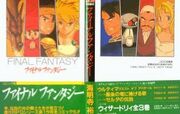
The cover for the manga. From left to right: Bahamut, Matoya, Flitz, Puffy, Garland, DB-6, Bikke and Sarah.
A manga adaptation of the game, titled simply Final Fantasy, was released 30 December 1989, illustrated and written by Yuu Kaimeiji. The manga was issued as a "Takarajima COMIC" by JICC and Publication Administration. The story follows partially that of the game, featuring the Warriors of Light: Puffy Tolte, the protagonist, an elven swordswoman who was transported from Elfheim against her will and told by the Circle of Sages to defeat Chaos; Flitz Stewart, a young monk that was kicked from his monastery for his vices; Matoya the witch, who appears as a young, carefree girl but claims to be hundreds of years old; and Bahamut, the King of Dragons.
The manga also features Garland, known as Red Garland, a knight of Cornelia who kidnaps the princess Sarah after she rejects his marriage proposal; the robot DB-6 (どぶろく, Doburoku?) who was entrusted by the Lufenians 400 years ago to guide the Warriors of Light; the princess Sarah (romanised as Sara) herself who accompanies the group on their journey after being rescued; and Bikke (romanized as Bicke), the pirate, who after being defeated becomes the party's navigator, piloting both his own ship and the airship for the group.
Novelization[]
As part of its Final Fantasy 25th anniversary celebration, Square Enix released a novelization of the first three Final Fantasy games. The novelization titled, Final Fantasy I * II * III: Memory of Heroes was released Fall 2012 in Japan and 2020 in other regions.
Production credits[]
Original Famicom version[]
| Programmed by | Nasir Gebelli |
|---|---|
| Character Design | Yoshitaka Amano |
| Scenario by | Kenji Terada |
| Square 'A-Team' | Hironobu Sakaguchi, Hiromichi Tanaka, Akitoshi Kawazu, Koichi Ishii, Kiyoshi Yoshii, Ken Narita, Kazuko Shibuya, Nobuo Uematsu |
Dawn of Souls version[]
| Producer | Takashi Tokita |
|---|---|
| Director | Kousuke Miyamoto |
| Remake Planners | Takashi Tokita, Hiroyuki Miura, Kousuke Miyamoto |
| Dialogue Assistant | Shota Shimoda |
| Music Supervisor | Nobuo Uematsu |
| Character Illustration | Gen Kobayashi |
| Coordinator | Kiyomi Tanikawa |
| Developed by | TOSE |
Packaging artwork[]
Gallery[]
Allusions[]
Final Fantasy took a lot of influence from Dungeons & Dragons, having numerous references to it. Later versions also make references to other Final Fantasy games.
A gravestone in Elfheim reads "Here lies Link", referring to the protagonist of Nintendo's The Legend of Zelda. In the American NES version, the gravestone instead reads "Here lies Erdrick" as a jab at Dragon Quest, the flagship series of Square's main competitor (at the time) Enix.
Trivia[]
- In Final Fantasy IV: The After Years, the Four Fiends are guardians for the True Moon crystals.
- The original Famicom release and MSX2 versions had some different graphics. Two of the most obvious changes are done to two types of monsters—the Medusa enemies were originally topless, while the Eye enemies were originally Beholders from Dungeons & Dragons. Later versions changed this, even the Japanese Final Fantasy I & II Famicom art. The Beholder graphic was restored in Dissidia Final Fantasy as player icons, but the revised graphics for Master, Red Wizard, and White Wizard remain.
- Some of the recurring aspects of the Final Fantasy series did not appear until later on. The original Final Fantasy did not feature a character named Cid until Cid of the Lufaine was first mentioned in the Dawn of Souls remake. Since chocobos were introduced in Final Fantasy II, this is the only game not to feature them, and is one of only three main series games not to feature moogles, as these were introduced in Final Fantasy III (with them being absent in Final Fantasy II and Final Fantasy IV as well).
- The lead designer of Final Fantasy IV, Takashi Tokita, has revealed the opening of Final Fantasy IV is intended to play partial homage to the opening of Final Fantasy, which he considers iconic of the series. "You start off playing the game as is, then you cross the bridge and the adventure starts in this whole expansive universe. The opening just starts suddenly. It's not the best graphics obviously, but the emotion and sentiment I got for getting into this deeper, expansive world, I really liked that."[10]
See also[]
External links[]
- Final Fantasy for Mobile Official Japanese Site
- Final Fantasy 20th Anniversary Official North American Site
- iTunes Store Purchase Page
- Googleplay Purchase Page
- Wikipedia Article
- Final Fantasy Classic, a site dedicated to this game
- Caves of Narshe Final Fantasy I Collection
- Final Fantasy I Shrine
- Final Fantasy Mages
Citations[]
- ↑ 1.0 1.1 (1989). MSX Magazine (January 1990 issue) . p. 19. ASCII Corporation. Archived from the original on 23 October 2023.
- ↑ Final Fantasy on Nintendo 3DS (Accessed: August 21, 2018) at Nintendo.co.jp
- ↑ Relive past glories with Nintendo's ultimate retro gaming experience (Accessed: October 01, 2016) at Nintendo
- ↑ Famitsu interview with Hironobu Sakaguchi (Japanese) (Accessed: August 21, 2018) at Famitsu.com (translation)
- ↑ 5.0 5.1 5.2 What's the Deal with Square Enix's Akitoshi Kawazu? (dead) (Accessed: September 21, 2013) at 1UP.com
- ↑ Things Are Very Different For The Creator Of Final Fantasy (Accessed: August 21, 2018) at Kotaku
- ↑ Final Fantasy's Hiroyuki Ito and the Science of Battle (dead) (Accessed: May 15, 2013) at 1UP.com
- ↑ Nasir Gebelli: Programming God (Accessed: August 21, 2018) at The Square Cave
- ↑ A day in the life of Nobuo Uematsu (dead) (Accessed: August 10, 2016) at www.NobuoUematsu.com (dead)
- ↑ Final Fantasy Masterminds Reminisce About Their Favorite Moments (Accessed: August 21, 2018) at Game Informer

